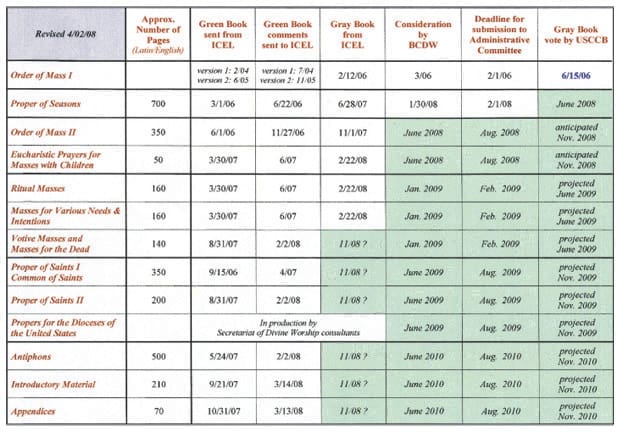Online Edition:
May 2008
Vol. XIV, No. 3
Progress report from BCDW
When Can We Hope to See the New Missal in English?
by Helen Hull Hitchcock
“When will we get the Missal translations? Why is this taking so long!”
These are questions we hear all the time. And we understand the frustration of pastors and parishioners who eagerly anticipate using the new Missal with its greatly improved translations — year after year after year — and who are trying to prepare prudently for the future.
The USCCB Committee on Divine Worship met in January to discuss the latest in a series of segments of the new Missale Romanum (Roman Missal) to be presented by the International Commission on English in the Liturgy (ICEL). These segments of the English translation of Mass texts arrive first as preliminary drafts (“Green Book”) for bishops’ comments; then ICEL sends a revised “Gray Book” to the conferences for vote. If this is approved by the conference, a final “White Book” Missal segment is sent to the Congregation for Divine Worship for final approval.
The process is arduous — and frustratingly slow. It has now been eight years since the third typical edition of the Missale Romanum was first released in April 2000. (It was released in final form in 2002.) ICEL, the international group responsible for preparing English-language translations, began its project of translating the new Roman Missal in 2003, after this “mixed commission” was reorganized by the Congregation for Divine Worship (CDW). The new translation reflects the principles of translation of the Holy See’s 2001 Instruction Liturgiam authenticam, as well as a set of more specific guidelines, called Ratio translationis, also produced by the CDW.
The Order of Mass was the first segment of the new Missal to appear in draft form, in February 2004. This is the core text of the Mass, and includes non-variable parts of the Mass, such as the Gloria, the Creed, the Eucharistic Prayers and responses by the congregation. The final version of this section was approved by the US bishops in June 2006. Other English-speaking bishops’ conferences also soon approved it, and it was sent to the Vatican, where it still awaits recognitio (official confirmation, approval) from the CDW, which is required before it may be used.
By November 2007, ICEL had completed the Green Book versions of twelve segments of the Missal (see chart below for a list of these segments), and announced its plan to complete its work by sending the remaining Gray Books to the bishops by the end of 2008.
Glossary of Terms
As an aid in understanding the various parts of the Missal, a mini-glossary might be helpful.
Ordinary – the part of the Missal that is constant, does not change with the seasons or special observances on the liturgical calendar.
Propers – special prayers and readings for the feasts and holy days on the liturgical calendar. There are Propers for Saints, and Propers for Seasons of the Church year. (There are also Propers for observances unique to the United States; for example, Thanksgiving Day, Saints John Neumann, Elizabeth Seton, Katherine Drexel, Mother Cabrini, among others. These Propers are not the work of ICEL, but are originally composed in English, not in Latin, and are the work of a special group assembled by the Bishops’ Committee on Divine Worship. These original texts also require approval by the bishops’ conference and the Holy See.)
Commons – parts of the liturgy (prayers, readings) that are common to a category of saints — such as martyrs, bishops, apostles — rather than “proper” to a particular day or saint.
Ritual Masses include the nuptial Mass, Masses for baptism, and confirmation.
At its meeting in January this year, the USCCB Committee on Divine Worship (BCDW) considered the Gray Book of the Proper of Seasons, which is a hefty 700 pages long. The BCDW recommended that this Gray Book be put on the agenda for the June 2008 bishops’ meeting in Orlando. A vote on the Proper of Seasons is now on the schedule for the June meeting — the only segment that the bishops will have a chance to vote on.
The BCDW also reviewed the bishops’ comments on three more Green Books at their January meeting:
1) Masses for Various Needs and Occasions,
2) Votive Masses and Masses for the Dead, and
3) the Antiphons.
The BCDW forwarded these books to ICEL, along with observations of the bishops and the committee itself. The next step is ICEL producing Gray Book versions of these segments.
Finally, the BCDW decided to produce a tentative timeline for the entire Missal translation project. A preliminary version was published in the committee’s February Newsletter.
The chart that appears below is a revised timeline made in April by BCDW officials, who kindly gave us permission to publish it for the benefit of our readers.
It should be stressed that this schedule is not set in stone. The shaded areas in the chart are all tentative and are subject to change based on ICEL’s completion of material as well as the workload of both the Committee on Divine Worship and the full body of bishops.
And remember, nothing has yet been approved by the Holy See.

***
*



